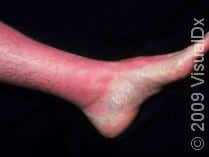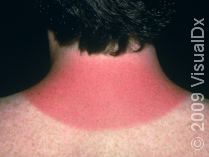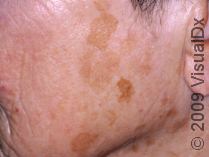With summer already here, it’s important for everyone to know a little bit more about sunburns. What is a sunburn exactly? A sunburn is exactly what it sounds. It is a burn caused by the sun. More specifically, a sunburn is caused by the ultraviolet component of sunlight. Both ultraviolet B (UVB) and ultraviolet A (UVA) can cause a sunburn. But, we know that UVB is the biggest culprit and causes the greatest amount of skin redness – the hallmark of a sunburn.

Why avoid sunburns?
There are three really good reasons why everyone should avoid sunburns.
- They really hurt.
- Sunburns increase your risk of skin cancers including melanoma, which can be fatal.
- Sunburns also cause skin aging.
How many people get sunburns every year?
A lot. Based on which scientific study you read, anywhere between 20% and 70% of people have had at least one sunburn in the past year. The rate seems to be highest for adolescents, teenagers, and young adults (ie, individuals 11-29 years of age). Every year in the United States, there are about 34,000 sunburn-associated visits to the emergency room, costing our healthcare system at least $11.2 million; again, these visits most commonly involve adolescents and young adults.1
What increases your risk of developing a sunburn?
UV Exposure: If you live closer to the equator (eg, in the Southern United States), your exposure to UVB is greater. Also, the time of day matters a lot. Peak UVB times can fall between 10 AM and 2 PM, depending on the location, but usually occur around noon. Remember, cloud cover can protect you from some UVB but not all. Snow, sand, and water can act as reflective surfaces and cause sunburns as well. If you’re hiking in the mountains or skiing, higher elevation means more UV exposure.
Skin Type: Anyone can get a sunburn, no matter the color of his or her skin, if exposed to enough UV radiation. But, fairer skin tones are more likely to burn; such individuals require less UV exposure to cause a sunburn. If you have red hair, numerous freckles, and paler skin, know that you’re at a much higher risk of burns.
Peer Pressure: Often for adolescents who enjoy outdoor activities, there is a desire to stay out and have fun with friends. But each individual has a unique threshold before a sunburn occurs. This requires being extra careful with sun protection and sun avoidance.
Alcohol: There is even some evidence that drinking alcohol can increase the risk of a more severe sunburn.2 When you’re drinking and having a good time, you may be less mindful about sun protection and stay out too long.
Sweating or Water Exposure: Some researchers have shown that by sweating, more UV radiation actually is absorbed by the skin, increasing the risk of sunburn.3
Medications: Certain medications can make you more sensitive to the sun. Common ones include an antibiotic called doxycycline, a drug used very often in acne. Griseofulvin is an antifungal drug used for ringworm and causes sun sensitivity as well.
Chronology of Sunburn
So let’s say you had a long day at the beach and the sun has just set. When can you expect a sunburn? Usually, a sunburn can begin as soon as 2 hours after sun exposure. The discomfort and redness seem to peak at 1 or 2 days later. Around that time, you may notice clear blisters in the areas of redness. The upper layer of skin may also begin to slough off after 2 days.
By 3 days, the redness should start getting better. The pain should be reduced. By 1 week to 10 days, the redness should be gone. Most people end up with a tan. However, some lighter skinned individuals may notice new brown spots. These are sun-induced freckles. You may even notice that some of your moles have gotten darker. If there is any concern about these spots, definitely ask your dermatologist to look at them.
Feeling Better After a Sunburn
The majority of sunburns are mild and get better on their own. In the meantime, there are a few things you can try at home to soothe the pain.
- Aloe vera gels can be cooling and comforting.
- Calamine lotion can be helpful to reduce the itch and pain associated with a sunburn.
- Cool compresses. Take a clean rag and wet under the faucet. Wring it dry so that it is still moist but not dripping. Gently apply to skin.
If you have a lot of blisters that have popped and desquamated, you can also do local wound care. We recommend petroleum jelly (eg, Vaseline) to keep open areas moist and speed wound healing.
Rarely and in cases of severe sunburns, individuals may complain of fever, nausea, and malaise. In these cases, over-the-counter nonsteroidal anti-inflammatory drugss (NSAIDs) such as ibuprofen (eg, Advil) or naproxen (eg, Aleve) can be helpful. Just make sure you check the packaging for correct child dosing and also other medical problems that would make taking an NSAID unsafe.
Safe Sun Tips
The only way to prevent a sunburn is sun avoidance. This means staying out of the sun completely and preferably staying inside during peak hours (from 10 AM to 4 PM). Remember, a sun umbrella alone is not sufficient. UVB and UVA can still reflect off of the sand and water. In one study, 78% of individuals still had skin redness after 3.5 hours on the beach under a sun umbrella.4
But, staying out of the sun isn’t always possible or reasonable. To stay safe in the sun, a good sunscreen is very important. Look for something that is at least SPF 30 or greater, has broad-spectrum protection noted on the label, and is water resistant. We also love sun shirts and other specialized sun clothing. These materials are woven to protect wearers from harmful UV rays more than regular clothing. The best thing about this clothing is that you don’t have to remember to reapply.
References
1. Guy GP, Berkowitz Z, Watson M. Estimated Cost of Sunburn-Associated Visits to US Hospital Emergency Departments. JAMA Dermatol. 2017;153(1):90-92. [PubMed]
2. Mukamal KJ. Alcohol consumption and self-reported sunburn: a cross-sectional, population-based survey. J Am Acad Dermatol. 2006;55(4):584-589. [PubMed]
3. Moehrle M, Koehle W, Dietz K, Lischka G. Reduction of minimal erythema dose by sweating. Photodermatol Photoimmunol Photomed. 2000;16(6):260-262. [PubMed]
4. Ou-Yang H, Jiang LI, Meyer K, Wang SQ, Farberg AS, Rigel DS. Sun Protection by Beach Umbrella vs Sunscreen With a High Sun Protection Factor: A Randomized Clinical Trial. JAMA Dermatol. 2017;153(3):304-308. [PubMed]
Last modified on April 30th, 2021 at 6:46 pm

